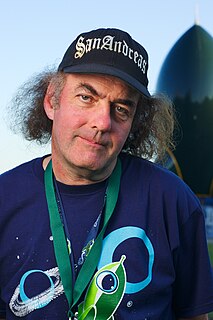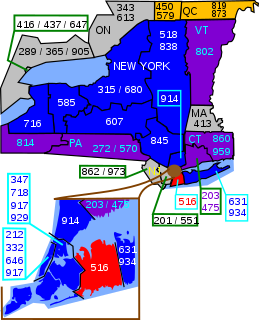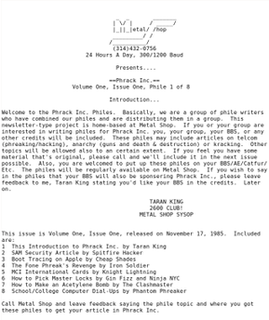
Phrack is an ezine written by and for hackers, first published November 17, 1985. Described by Fyodor as "the best, and by far the longest running hacker zine," the magazine is open for contributions by anyone who desires to publish remarkable works or express original ideas on the topics of interest. It has a wide circulation which includes both hackers and computer security professionals.
Masters of Deception (MOD) was a New York-based group of hackers, most widely known in media for their exploits of telephone company infrastructure and later prosecution.
The Great Hacker War was a purported 1990–1992 conflict between the Masters of Deception (MOD) and an unsanctioned splinter faction of the older guard hacker group Legion of Doom (LOD), amongst several smaller subsidiary groups. Both of the primary groups involved made attempts to hack into the opposing group's networks, across Internet, X.25, and telephone networks. In a panel debate of The Next HOPE conference, 2010, Phiber Optik re-iterated that the rumoured "gang war in cyberspace" between LOD and MOD never happened, and that it was "a complete fabrication" by the U.S attorney's office and some sensationalist media. Furthermore, two other high-ranking members of the LOD confirmed that the "Great Hacker War" never occurred, reinforcing the idea that this was just a competition of one-upsmanship and not a war.
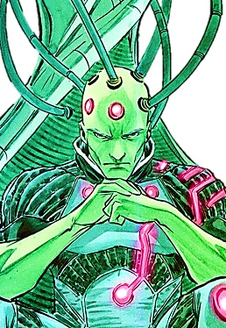
Brainiac is a fictional supervillain appearing in American comic books published by DC Comics, usually as an adversary of Superman, his second deadliest archenemy after Lex Luthor, and a frequent enemy of the Justice League.

Mark T. Abene is an American infosec expert and entrepreneur, originally from New York City. Better known by his pseudonym Phiber Optik, he was once a member of the hacker groups Legion of Doom and Masters of Deception.

Jason Scott Sadofsky, more commonly known as Jason Scott, is an American archivist, historian of technology, filmmaker, performer, and actor. Scott has been known by the online pseudonyms Sketch, SketchCow, and The Slipped Disk. He has been called "figurehead of the digital archiving world".

Black Manta is a fictional supervillain appearing in American comic books published by DC Comics. Created by Bob Haney and Nick Cardy, the character was introduced in Aquaman #35 as a ruthless and murderous underwater-based mercenary, and has since endured as the archenemy of the superhero Aquaman.
A security hacker is someone who explores methods for breaching defenses and exploiting weaknesses in a computer system or network. Hackers may be motivated by a multitude of reasons, such as profit, protest, information gathering, challenge, recreation, or to evaluate system weaknesses to assist in formulating defenses against potential hackers. The subculture that has evolved around hackers is often referred to as the computer underground.

Bruce Fancher is a former computer hacker and member of the notable Legion of Doom hacker group. He co-founded MindVox in 1991 with Patrick K. Kroupa.

The Hacker Crackdown: Law and Disorder on the Electronic Frontier is a work of nonfiction by Bruce Sterling first published in 1992.

Belle Reve Penitentiary is a fictional prison and sanatorium appearing in American comic books published by DC Comics. The prison first appeared in Suicide Squad #1, written by John Ostrander and art by Luke McDonnell.
OSUNY was a dial-up bulletin board that was run by two different sysops in the 1980s, "Sysop" while in Scarsdale, New York, and Frank Roberts in White Plains, New York. Named for the Ohio Scientific computer it originally ran on, it attracted a large group of hackers, phone phreaks, engineers, computer programmers, and other technophiles. It remained a haven almost exclusively for the hacker/phreaker community until gaining notoriety through mention in a Newsweek article, Hacking Through NASA: A threat- or only an embarrassment, and mention in the book The Hacker Crackdown as a favored hangout of the notorious hacker group The Legion of Doom, after which it was shuttered, and another board was brought up as a "replacement" known as The Crystal Palace, which was short-lived. OSUNY was restarted soon after, using an Altos 5-15D running MP/M and the continuously evolving Citadel/UX software. Also in the mid-1980s it became the first BBS to be associated with 2600 Magazine. It ran via dial-up until its closing around 1988.
Lex Luthor is a fictional supervillain appearing in American comic books published by DC Comics. As Superman's archenemy, he has been portrayed in almost every Superman media franchise and adaptation.
GBBS is a bulletin board system (BBS) program for the Apple II. Its first series, named GBBS, was written in Applesoft and used by boards such as Demon Roach Underground in Lubbock, Texas Its successor, GBBS Pro, was ACOS-based. GBBS-Pro was used by boards like ProBOARD II in Paso Robles, California, Scotland Yard GBBS/AE Pro in Cincinnati, Ohio, No Earthly Connection in Blue Ridge, Georgia, and Apple Elite II in Riverside, California.
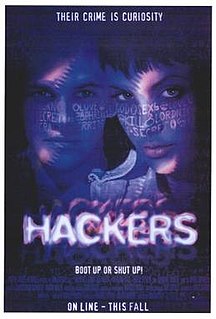
Hackers is a 1995 American crime film directed by Iain Softley and starring Jonny Lee Miller, Angelina Jolie, Renoly Santiago, Laurence Mason, Matthew Lillard, Jesse Bradford, Lorraine Bracco, and Fisher Stevens. The film follows a group of high school hackers and their involvement in a corporate extortion conspiracy. Made in the 1990s when the Internet was unfamiliar to the general public, it reflects the ideals laid out in the Hacker Manifesto quoted in the film: "This is our world now... the world of the electron and the switch [...] We exist without skin color, without nationality, without religious bias... and you call us criminals. [...] Yes, I am a criminal. My crime is that of curiosity." Despite receiving mixed-to-negative reviews and failing at the box office upon release, Hackers has since achieved cult classic status.

